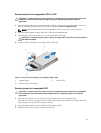
• Populate up to two quad-rank RDIMMs and up to three dual- or single-rank RDIMMs for each
channel. When you populate a quad-rank RDIMM in the first slot with white release levers, the third
DIMM slot in the channel with green release levers cannot be populated.
• Populate up to three LRDIMMs regardless of rank count.
• Populate all sockets with white release tabs first, then black, and then green.
• Do not populate the third DIMM socket in a channel with green release tabs, if a quad-rank RDIMM is
populated in the first socket with white release tabs.
• Populate the sockets by highest rank count in the following order — first in sockets with white release
levers, then black, and then green. For example, if you want to mix quad-rank and dual-rank DIMMs,
populate quad-rank DIMMs in the sockets with white release tabs and dual-rank DIMMs in the sockets
with black release tabs.
• The memory configuration for each processor must be identical. For example, if you populate socket
A1 for processor 1, then populate socket B1 for processor 2, and so on.
• You can use different sizes of memory modules, provided that other memory population rules are
followed (for example, you can use 2 GB and 4 GB memory modules).
• Populate four DIMMs for each processor (one DIMM per channel) at a time to maximize performance.
• If memory modules with different speeds are installed, they operate at the speed of the slowest
installed memory modules or slower depending on system DIMM configuration.
Mode-Specific guidelines
Four memory channels are allocated to each processor. The allowable configurations depend on the
memory mode selected.
NOTE: You can use x4 and x8 DRAM-based DIMMs, providing support for RAS features. However,
you must follow all guidelines for specific RAS features. x4 DRAM-based DIMMs retain Single Device
Data Correction (SDDC) in memory optimized (independent channel) mode. x8 DRAM-based
DIMMs require Advanced ECC mode to gain SDDC.
Install identical DIMMs in matched pairs - for example, A1 with A2, A3 with A4, A5 with A6, and so on.
Sample memory configurations
The following table shows sample memory configurations that follow the appropriate memory
guidelines.
Table 26. Sample memory configurations
System Capacity (GB) DIMM Size Number of DIMMs DIMM Slot Population
128
32 4 A1, A2
B1, B2
256
32 8 A1, A2, A3, A4
B1, B2, B3, B4
384
32 12 A1, A2, A3, A4, A5, A6
B1, B2, B3, B4, B5, B6
512
32 16 A1, A2, A3, A4, A5, A6, A7, A8
B1, B2, B3, B4, B5, B6, B7, B8
42


















